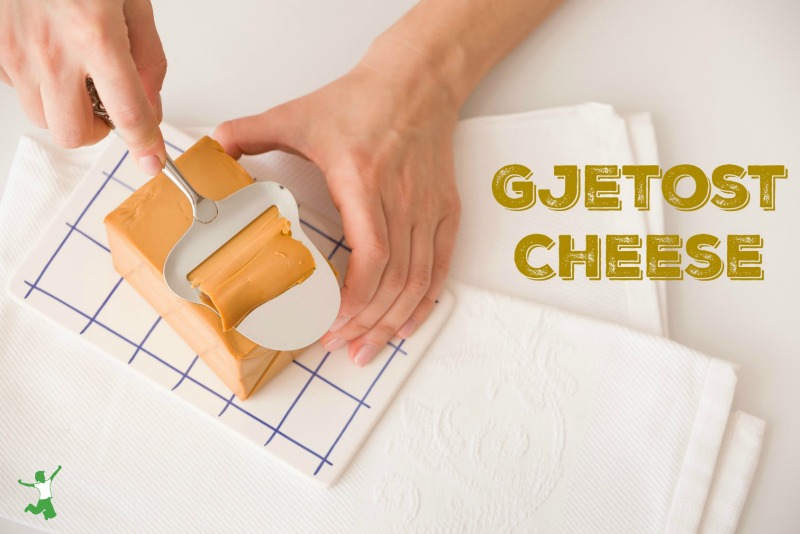Easy recipe for homemade gjetost cheese traditional to Norway that can be made with leftover liquid whey from other culinary activities.
My friend Mary recently mentioned to me that she was drowning in whey.
She had a gallon or two of raw milk that had soured and she wisely decided to allow it to naturally separate on the kitchen counter. She then strained the clabbered milk into cream cheese and whey.
The raw cream cheese could be blended with a bit of maple syrup and strawberries to make a lovely raw spread for a morning bagel, but what about all that whey?
I suggested that some of the whey could be used for fermenting probiotic loaded vegetables and fruits such as beet kvass or sauerkraut. But, Mary said she had so much, there was no chance she would use all of it for that purpose.
Help!
Homemade Gjetost Cheese
In situations like this, use the extra whey to make traditional Norwegian gjetost cheese (pronounced “yay-toast”).
This simple, healthy cheese is made by boiling down whey for a number of hours until it is reduced to a quarter or less of its original volume. When the gjetost cheese is almost ready with the whey almost boiled down, you add some cream to enhance the smoothness and flavor. The color as it boils down gets darker and darker.
Believe it or not, that is all there is to it!
Gjetost cheese tastes somewhat like cultured butter with some cheddar overtones and can be served as a sauce for pasta similar to a creamy alfredo sauce.
You can also use gjetost cheese to flavor vegetables or enhance the flavor of soups.
The idea is to boil it down to the desired consistency for the appropriate culinary use.
You may use the whey from either cow or goat milk to make your gjetost cheese. Know that if you make it from goat whey which is the traditional way to do it, it will definitely taste a bit goaty.

Homemade Gjetost Cheese Recipe
Easy recipe for homemade gjetost cheese traditional to Norway that can be made with leftover liquid whey from other culinary activities.
Ingredients
- 1/2 gallon liquid whey FRESH, not leftover from cheesemaking
- 1/2 cup cream preferably organic and grassfed
Instructions
-
Pour the whey into a large pan and bring to a low boil. Simmer uncovered for 2-3 hours stirring frequently until the whey has been reduced to the texture of thick gravy and is about 1 pint in volume.
* This is a great task to start right after breakfast and it will be done by lunchtime.
-
Stir in cream and continue to simmer stirring often until desired consistency is reached.
-
Remove from heat and let cool for a few minutes. Blend the gjetost cheese with a stick blender to enhance creaminess and serve warm immediately as a pasta sauce or pour into containers to refrigerate for later use.
-
Gjetost cheese will solidify a bit in the refrigerator and will last for about 1 month. It is delicious cold as a spread on crackers.

More Recipes for Homemade Cheese
How to Make Ricotta Cheese
Homemade Quark recipe
How to Make Whey and Cream Cheese
Cheesemaking: Common Problems and Solutions
How to Make Yogurt Cheese
Perfect Cottage Cheese








How long is the whey good? I make a soft cheese spread with some of the kefir I make & I wasn’t sure what to do with the whey. I froze some & kept some in my fridge. How long is it good in the fridge?
Thank you MacLaren Scott for replying! Man I sure was worried there they were messed up. I just put them in some fresh milk awhile ago and the little grains are soooo tiny and not holding together like cauliflower. 🙁 BUT it did get really thick but it took more than 24 hours to do so. It is sour to but not to the point like lemons. lol I just HAD to taste it to see how it tasted. Yesterday evening was my 24 hour mark and this morning I woke to some thick mass in the jar. I strained it as best I could with a clean cloth and I had about 3 good tbl. of stuff to put back in the new batch. I tried my best to get all the larger pieces of grains that I could out of the jar. I’ve never even heard of kefir until about 3 weeks ago! I can’t wait to have enough to make cream cheese or other things with it. I put my whey in the jar I used so I could shake it up and get all the goodie out of the jar and then stuck it in the fridge.
Thank you again for answering my questions! I sure hope my grains get larger soon and start clumping together.
I have a question. I just ordered some kefir grains and this is my first time to do this. I wanted to start making kefir to. When I got my grains yesterday it was a tablespoon of them. They came in a ziplock and I followed the directions to a T. Read them and then REREAD them just to be on the safe side. AFTER I get the stuff in the jar with the two cups of milk and the cover of a coffee filter over it I sit down and look at my receipt that was also sent with the grains. ON the recipe it says to wash the kefir and I was like now the direction page didn’t say anything about washing it NOR did it say to pour off the juice stuff that was in the bag with the grains. 🙁 So here I have poured the liquid stuff and the grains in my 2 cups of milk. Will it be OK now? That was at 5:20 yesterday evening and my 24 hours will be this evening. I picked the jar up looking at it and it doesn’t appear to be getting thicker. Although I do see a line around the top of the jar that looks a little thick but it’s just on the jar. Also they were put into my mail box and sit out there in that hot mailbox for probably a good 2 hours and they were MEGA HOT when I opened the package. I had NO IDEA when they would come since they said June 13th. I let them cool off on the counter before I added the milk to them.
This is not really my place to reply as it is not my blog, but I am a kefir fanatic and make kefir daily from grains that I have had for a long time. Keifr is one of the most forgiving things to make that I have ever experienced. It really doesn’t seem to care about moderate temperature fluctuations, can sit at room temp in my dark cupboard for 2-4 days (winter or summer) and still be just fine, although the longer it sits, the thicker and tangier it gets. If i forget about it for a few days and it gets super thick, I strain out the grains and then plop it into a butter muslin or cheese clothe and let it drip for a bit to make kefir cheese. I have never had the grains make decent kefir after just 24 hrs though – it always takes longer here (7000′ may make a difference). And we keep our house on the cool side. Sometimes I rinse the grains and sometimes I don’t and it has never made a difference. The only thing that reduces it’s potency is making too many batches of coconut kefir in a row, or storing it in water in the fridge for too long. But I have given grains I thought were dead to a friend and she was able to bring them back to life. She split them again and gave them back to me and they are growing like crazy in my fresh, raw goat’s milk. I even shipped grains to Hawaii and that friend says they are doing great. I say give them time and they will be fine. 🙂
Hi MacLaren, Would you be interested in sending me some kefir grains? And do you ship goat’s milk? I am needing either cow or goat milk badly. I am having cow milk shipped from a long distance and the shipping is really hurting my finances. I am in Wyoming . Thank you .
Hi Linda,
I can totally ship kefir grains to you – no problem! But I would not be comfy shipping goat milk as it is raw and I only have one goat. I can not even keep up with the demand of my family’s needs and those of a few local friends. I have found facebook to be a real boon in networking. Here in Taos I would be able to find goat milk quickly by posting it on FB. Can you try that? Send me an email to [email protected] and we’ll figure out how to get the grains to you.
Thank you for replying! I rely on my experienced readers to help out with the commenting load on occasion! I appreciate the time you took in responding 🙂
Glad that was OK Sarah. I’m actually shipping some grains off to Linda today. It’s fun to share with strangers. And I am incredibly impressed at how many comments you have received on this post! I hardly ever get comments on my blog! 🙂
Do you know why you can’t use left over whey from cheese making? Why will it wreck the baby formula? I think I used it when I made formula and never noticed any problem, but if I ever have to use the homemade formula again, I would really like to know why I can’t use the leftover whey from making fresh mozzarella.
I grew up on Gjetost as I am from Norwegian descent. The Gjetost we had was a harder type cheese that had to be sliced and was very creamy in taste and brown in color. What you’re describing is not what we ate.
Ahhhh… and the gjetost you are describing is the only gjetost I have ever had, introduced to it while living in Norway. Do you know how to make THAT type?
I was born and raised in Norway, and gjetost definitely is very firm and can be sliced into skinny, stiff slices. I’m sure that getting it to firm up like this has to do with cooking time. In Norway this cheese is also make in iron pots traditionally; not sure if they still do, but they at least used to and gjetost was therefore a good source of iron.
How long does whey last? For some reason I can’t remember, I had a couple of gallons that soured in the refrigerator almost 2 years ago. I still have them in the back of a second fridge in the garage. They are mostly whey with some solids at the bottom of the gallon. They smell just like fresh whey and I used some in place of buttermilk for pancakes (not soaked) which were great. Has it lost any nutritional value even though it tastes fine and doesn’t cause problems? Would it work for this cheese? Thank you!!
If whey is so good for us as a raw probiotic, doesn’t boiling it destroy the beneficial enzymes?
Yes, it does. But the point here is what to do with they whey so as not to waste it entirely when you have too much to use any other way…
I don’t make as much regular whey because of my focus on dairy kefir, however, when I did have a surplus, I simply poured a glass, added salt and pepper, & down the hatch.
The gjetost-cheese is intriguing, though.
Pavil, the Uber Noob